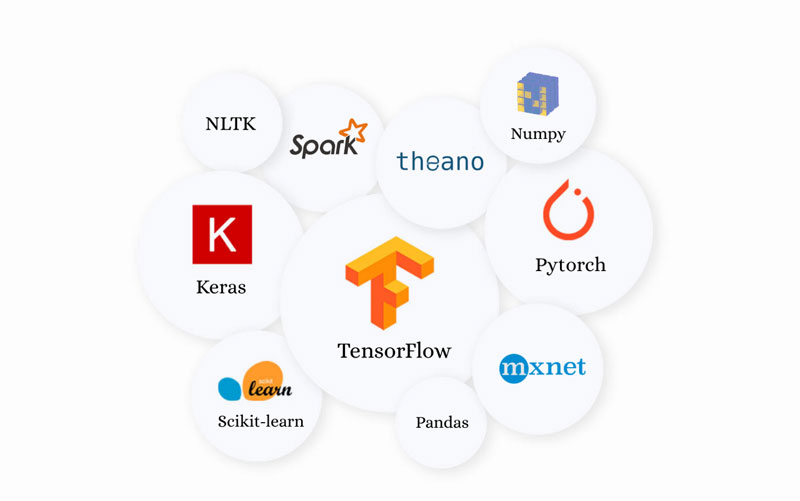
According to TIOBE and their November 2021 statistics, Python is currently the most popular and in-demand programming language, beating the likes of giants such as Java, C, and C++. In this article, you see why Python is so popular. Also, you will understand better what all of Python’s real-world applications are and why our Python certificate course might be the perfect choice for you.
But, first, let’s talk about the history of Python. To create this popular programming language, we have to thank Guido van Rossum who developed it in 1991. Van Rossum was looking for a hobby that would keep him busy during Christmas vacation. So, he decided to write an interpreter for a new programming language. This idea was in his head for a certain period. Still, he finally had enough time to develop it around the holidays. He ended up naming it “Python” after Monty Python.

Van Rossum couldn’t have possibly known that he created one of the greatest programming languages in the world. But, of course, Python significantly changed since its creation. Now we use it for anything we can imagine. If you’re wondering where Python programming is used, there is a straightforward answer – everywhere!
Why is Python so popular?
We already know that Python does it all, but let’s take a closer look at why so many programmers choose Python as their number one programming language. This makes Python one of the most used programming languages in the world.
Simplicity
One of the things that Van Rossum emphasized was the DRY principle (Don’t Repeat Yourself). He wanted Python to be easily readable and simple. Thanks to this feature, Python is easy to use and learn, even if you are new to programming. This is one of the essential characteristics.
“
The joy of coding Python should be in seeing short, concise, readable classes that express a lot of action in a small amount of clear code — not in reams of trivial code that bores the reader to death.
Van Rossum
Large collection of libraries
Another important feature of Python is its extensive collection of libraries that you automatically download when downloading Python. Since they are built-in, you don’t have to worry about writing individual codes. These collections of libraries and packages include web browsers, image manipulation, threading, regular expressions, databases, email, unit testing, documentation generation, CGI, and much more.
Open-source
The open-source feature means that you don’t need to pay to install and use Python and that the source code is available to the public. Furthermore, since Python supports the FLOSS model, users can change and distribute the source code, allowing the Python community to improve its features.
Interpreted, object-oriented and functional language
Python is an interpreted language which means that instead of compiling the code and then running it all at once, Python executes it line by line. Thanks to this, debugging Python is much easier because it enables you to do it while coding. Additionally, Python can model real-world data because it’s an object-oriented language. Finally, Python is also functional, which means using code repeatedly is possible.
Portable, embeddable and extensible language
The portability of Python means that a Python code is highly flexible. For example, if you write a code for a Windows machine, it can also run on iOS. This is very important because you don’t need to write different codes for different machines. You can also embed your Python code in the source code of other languages, allowing you to integrate Python’s scripting functionalities into other codes. Finally, Python’s extensible feature means that you can even write some parts of a Python code in other programming languages, for example, in C++.
Who uses Python today?
Python is now everywhere. From freelance programmers to government agencies, financial institutions, and giants such as Google – everyone uses Python. The typical job positions are Python developer, Web developer, and Back-end developer when it comes to Python programming.
These use Python to develop apps, websites, games, and more. Finally, we need to mention Data scientists who use Python to compute large amounts of data. Python’s data science usage is beneficial for machine learning and AI since Python can access machine learning frameworks.
Everyone likes to hear some fun facts, so here are some for you: Youtube is largely written in Python, just like Instagram, Reddit, and Pinterest. Python is also used by giants such as Netflix, IBM, Intel, Facebook, Spotify, NASA, and others. It’s also one of the four main programming languages at Google, but we can’t forget PayPal, Dropbox, and Uber either.
Many people who want to get into Python basics can be indecisive because they aren’t sure if they would be able to find well-paid jobs afterwards. Well, be sure there is no reason to worry. Statistics from Salary Explorer say that the average salary for Python developers is more than 140,000 RSD. If you know some other programming languages, enrolling in a Python course can only help you earn more.
If you somehow still aren’t convinced that Python is the right choice for you, let’s look at all examples of Python uses in real life.
Where is Python used in the real world?
1. Web development
Python comes with a wide range of web frameworks and content management systems (CMS) whose purpose is to make a web developer’s life easier. Some of the most popular frameworks are Django, Flask, and Pyramid, alongside CMS like Plone and Django CMS. These frameworks are filled with modules and libraries such as Requests, Beautiful Soup, Paramiko, Twisted Python, and Feedparser. These significantly simplify database interaction, content management, and interfacing with internet protocols. In addition, Python web frameworks are known for their security, flexibility, and scalability. This is another reason why web development is a contestant for the number one Python application.

2. Game development
We heard the question “Can Python be used to make games?” way too many times, and now it’s time to answer it once and for all – yes! Python’s extensions and libraries that we mentioned before come in handy in game development. Python is the building stone for popular games like Battlefield 2, World of Tanks, Sims, Civilization IV, and Eve Online. Apart from game development, game designers use Python to develop tools that help simplify some actions in-game. Such as creating a tree dialogue or for levelling design.
3. AI and Machine Learning
This is probably a unique application of Python because AI and machine learning are among the hottest topics of the decade, and this popularity will only grow with time.
Artificial intelligence and machine learning depend on Python to handle the computations required to build AI and ML models. These models are different from regular software projects because the tools and technologies we use are entirely different. AI and ML applications need Python because it’s a simple, stable, flexible, and secure language with all the necessary tools to handle the unique requirements of such projects. Some of the best Python library packages for AI and ML are:
- SciPy for advanced technical and scientific computing
- Keras for artificial neural networks
- Pandas for manipulation and data analysis
- TensorFlow for machine learning tasks
- NumPy for complex mathematical functions

4. Data analysis
Data is key to understanding people, their taste in things, and their opinions on important issues in the modern world. We can get to know so many things about people we never even met by gathering and analysing data. Can you now imagine what data science can do with inanimate objects?
Data analysis is a process of identifying a problem, collecting and analysing data, and finally visualising it. Here is where Python comes in handy since it offers libraries essential in tackling data science. Libraries such as TensorFlow, Pandas, PyTorch, NumPy, and Scikit-Learn specialise in performing intensive data crunching and manipulation. Data visualisation comes into play when you need to present your findings to your team or the stakeholders. For this purpose, Python offers libraries such as Plotly, Seaborn, Matplotlib, Ggplot, and Geoplotlib.
5. Business applications
Experts can program in Phyton for almost any kind of app development, but business applications are where Python excels. Business applications are different from standard applications because they are designed to fit the requirements of a company rather than the needs of individual users. This means that the apps need to integrate with legacy systems like non-web apps and existing databases.

Python’s security, scalability, high performance, flexibility, and readability are required for developing efficient business applications. In addition, however, Python offers specific tools for business application development, such as Odoo and Tryton. Odoo, as an all-in-one management software, and Tryton, as a general-purpose application platform, are the building blocks of various business applications.
6. Software development
The scope of Python programming goes beyond what we mentioned above. Some aspects of Python make this programming language perfect for software development of any kind. Python packages and applications help simplify the process of software development with features such as quick executions, high compatibility, and an enormous collection of libraries.
Apart from its usage as the primary programming language in projects, software developers also use Python to support build control, project management, and testing. The built-in Python tools include Roundup, Buildbot, Allura, SCons, Trac, Apache Gump, Orbiter, and Mercurial. For example, Buildbot and Apache Gump are designed for automated compilation and testing, SCons for build control, and Roundup and Trac for bug tracking and project management.
To sum up…
As we mentioned above, there is no area of business or industry that can’t find a way to use the Phyton programming language and its benefits. The good news is that we are witnessing one of the highest demands for people who know how to code in Phyton. This means that investing in achieving this kind of knowledge is an investment in your future. In the words of NIT Academy’s instructor, professor Ivan Kaštelan:
“Python is becoming more and more popular and it’s difficult to find an area of software engineering in which we can’t use Phyton”.
If you want to know more about NIT Academy’s Python course, don’t hesitate to contact us for more information or head to our website.






